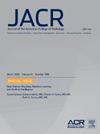医生同意放射科医生建议的随访成像的预测因素。
IF 4
3区 医学
Q1 RADIOLOGY, NUCLEAR MEDICINE & MEDICAL IMAGING
引用次数: 0
摘要
目的:虽然放射学报告中经常会建议进行额外的影像学检查,但并非每次都能完成后续影像学检查,这可能反映出放射科医生和转诊医生之间存在分歧。我们评估了转诊医生同意放射科医生随访建议的频率、出现分歧的原因以及放射科医生与转诊医生达成一致的相关因素:这项由机构审查委员会豁免的回顾性研究是在一家大型学术中心进行的。通过 PACS 集成工具,放射科医生可将随访成像建议发送给转诊医生,转诊医生使用该工具记录同意或不同意建议的情况。研究包括2019年10月21日至2022年10月31日期间为门诊患者发送的建议。研究人员进行了多变量逻辑回归分析,以确定与放射医师-转诊提供者协议相关的患者、放射医师和成像检查因素:在符合纳入标准的 9406 项建议中,有 8331 项(88.6%)达成了一致。不同意的最常见原因是认为建议与临床无关(44.5%,478/1,075)。以下因素与低同意率有关:转诊医生是外科医生(Odds Ratio [OR] 0.73,pDiscussion:转诊医生经常同意放射科医生为门诊病人提出的随访成像建议,病人的人口统计学和社会经济因素似乎对放射科医生与转诊医生的一致意见没有显著影响。本文章由计算机程序翻译,如有差异,请以英文原文为准。
Predictors of Physician Agreement With Radiologist-Recommended Follow-up Imaging
Objective
Although recommendations for additional imaging are common in radiology reports, completion of follow-up imaging does not always occur, which could reflect disagreement between radiologist and referring provider. We assessed how frequently referring providers agree with radiologists’ follow-up recommendations, reasons for disagreement, and factors associated with radiologist-referring provider agreement.
Methods
This institutional review board-exempt, retrospective study was performed at a large academic center. A PACS-integrated tool allowed radiologists to send follow-up imaging recommendations to referring providers, who used the tool to document agreement or disagreement with recommendations. The study included recommendations sent for outpatients between October 21, 2019, and October 31, 2022. Multivariable logistic regression analysis was performed to identify patient, radiologist, and imaging examination factors associated with radiologist-referring provider agreement.
Results
Of the 9,406 recommendations meeting inclusion criteria, 8,331 (88.6%) resulted in agreement. The most common reason for disagreement was that the recommendation was considered not clinically relevant (44.5%, 478 of 1,075). The following factors were associated with low rates of agreement: referring provider being a surgeon (odds ratio [OR] 0.73, P < .001) or recommendation for follow-up nuclear imaging (OR 0.64, P = .012). The odds of agreement were higher for recommendations made by thoracic radiologists (OR 1.41, P = .002) and for recommendations with longer follow-up time frames (weeks) (OR 1.03, P < .001). Patient race, ethnicity, insurance type, and living in a socio-economically disadvantaged neighborhood were not significantly associated with radiologist-referring provider agreement.
Discussion
Referring providers frequently agree with follow-up imaging recommendations made by radiologists for outpatients, and patient demographics and socio-economic factors do not seem to significantly impact radiologist-referring provider agreement.
求助全文
通过发布文献求助,成功后即可免费获取论文全文。
去求助
来源期刊

Journal of the American College of Radiology
RADIOLOGY, NUCLEAR MEDICINE & MEDICAL IMAGING-
CiteScore
6.30
自引率
8.90%
发文量
312
审稿时长
34 days
期刊介绍:
The official journal of the American College of Radiology, JACR informs its readers of timely, pertinent, and important topics affecting the practice of diagnostic radiologists, interventional radiologists, medical physicists, and radiation oncologists. In so doing, JACR improves their practices and helps optimize their role in the health care system. By providing a forum for informative, well-written articles on health policy, clinical practice, practice management, data science, and education, JACR engages readers in a dialogue that ultimately benefits patient care.
 求助内容:
求助内容: 应助结果提醒方式:
应助结果提醒方式:


